Indelible fabric dyes

Even the most durable items lose their presentable appearance over time. Colors become less vivid, and the item looks washed out and unkempt. But do not rush to the store for a new one, because the old one can be returned to its original look. This can be done with fabric paint, which is then not washed off with water.
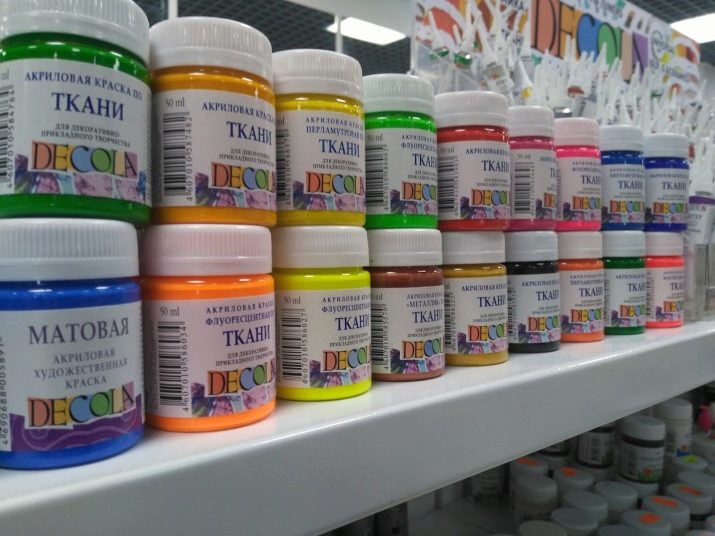
Views
The range of paints for painting and drawing on fabric is huge today. Dyes can be very different in the form of release. These are aerosols, and powder formulations, and contours for marking, and liquid mixtures, and even paste-like ones. It is worth learning more about the main types of coloring compositions.
Acrylic
Acrylic paints, the main component of which is artificial resin, are breaking all records in popularity today.... They are used not only for dyeing fabrics, but also for painting on wood, glass, and other materials. These paints are always included with paintings for drawing by numbers.
The main advantage of this paint is the ability to dry quickly. It takes literally a matter of hours. A thing painted with acrylic takes on a light shine and a spectacular appearance. There are incredibly many shades of dye: these are white, black, red, blue, and many other options. There are solutions for gold and silver, there are options with a metallic or matte sheen.

Acrylic paints are environmentally friendly and also have almost no smell. The aroma is subtle, almost imperceptible, there is nothing unpleasant in it. Dyes easily fall on clothes, they are simply distributed over it. They can be mixed with each other, creating new shade options, as well as diluted with water or a special agent. Once dry, the paint will be indelible.In dyed clothes, you can safely walk in the rain. But it is best to wash it by hand.
The following types of clothing can be dyed with acrylic:
-
cotton;
-
woolen;
-
silk.
Do not use the dye for children's clothing, underwear, bedding.
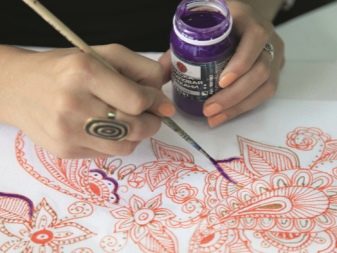

Aniline
The previous version of the paint is applied with a brush along the contour, that is, there will be no uniform staining in a certain color, only a certain pattern can be made. Aniline dye is another matter. You will definitely need it if you want to completely repaint and update a piece of clothing. Such solutions are available in the form of liquids or bulk formulations.
It is recommended to use them on clothes made from natural types of fabrics, but bedding and underwear are also prohibited here.


Aniline compounds are diluted in water in a ratio of 1: 30, and then the liquid is brought to a boiling state. Next, the thing is dipped into the painted water and boiled. The longer the process lasts, the darker and richer the color will turn out. On average, a few minutes are enough.
After the digestion comes to an end, the result will need to be fixed. To do this, pour a couple of tablespoons of salt into the colored water. Wool is additionally strengthened with a tablespoon of vinegar, and cotton fabrics with the same amount of baking soda. Then all that remains is to rinse the thing. But you cannot twist it, since this will cause the paint to stain and stain.

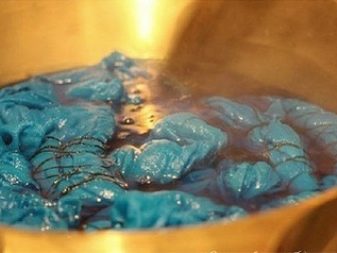
Stamp
Such dyes are rarely used at home. They are mainly used in the hotel business, in the railway industry. Probably everyone has seen some kind of marks on bed linen in hotels, as well as on the one that is issued for night travel on trains. These marks are obtained from the stamp ink.
Stamp options for paints can have a different basis. For example, alcohol-based solutions are the most effective. Such things do not lose color during washing, they can be bleached, starchy.

Water-glycerin options are presented in a dark palette. They are washed at high temperatures. Oil-based models are slow drying, but then they are not afraid of water or shedding. The last type of dyes is colorless. They can only be seen if the fabric is exposed to ultraviolet light.
Stamp dyes are not used for clothing at home. They can be used to create patterns on bed linen, towels, and other textiles.

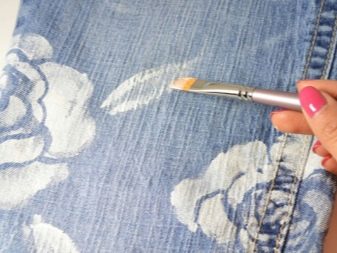
Plastisol
These paints create patterns and designs on fabrics, but they are not suitable for full dyeing. These dye options are luminous. They are suitable for clothing that is used in the dark... For example, athletes and cyclists who exercise at night can use them to color their clothes. And also plastisol dye will be an excellent choice for people who like to attract attention in nightclubs and discos. The paint can be applied not only to clothes, but also to shoes. During the day, the shade is most often invisible, but with the onset of darkness, it acquires a spectacular shimmer and a variety of colors.


Natural
Such options also take place, and they were invented long before the invention of industrial dyes. Most paints of natural origin are suitable for people with allergies, but it is important to consider your own reactions. In addition, natural specimens are much less durable. And they should be used only after preliminary testing.
You can find a lot of natural colors. For example, turmeric, celandine, orange peel are used to dye clothes yellow. Brown color is obtained from tea, oak bark, onion husks. For red, you can take beets. For blue - blackberries, green - brilliant green solution.



The dyeing process will not cause difficulties even for a teenager. You just need to add the selected dye to the water, lower the thing there, heat it (60 degrees). ZThen let stand for about half an hour, rinse.To preserve the resulting shade, the result is fixed with a 1% solution of potassium dichromate or copper sulfate. The holding time in the fixing composition is 5 minutes. Then another rinsing is carried out.


Aerosol
Spray paints are very easy to use. They can be of very different composition. Using them is very simple: you just need to unscrew the cap and spray the dye on the desired area. To prevent the aerosol from getting on the area that does not need to be painted, the thing should be prepared in advance. All untreated areas must be covered with cardboard or thick cloth.
Spray paints are less comfortable. If the dye from the aerosol comes in a dense spray jet under pressure, then the spray is applied more dropwise, pointwise. You will have to practice here.
By the way, you can paint with sprays and aerosols any types of fabrics: natural, synthetic, and mixed solutions.


Glowing
In addition to the already mentioned plastisol paints, there are also luminescent ideas. They are most often applied with a brush or by spraying, it all depends on the form of release. Luminescent paints glow beautifully in the dark, they are almost invisible during the day. The main components of the composition are synthetic components, not phosphorus, which means that the product will not harm human health.

Top manufacturers
Today, different brands are engaged in the production of dyes for clothes. Some of them have already won the love of buyers and first places in the ratings.
-
Simplicol. Excellent leave-in paints designed for complete dyeing of clothes. The manufacturer took care not only of the coloring powder, but also of a special tool that allows you to reliably fix the color. Each paint has a scale of shades, so it is very easy to calculate the desired color.
If you want bright colors, then on average the packaging is enough for 300 grams of fabric. The paler the color, the more material you can paint.
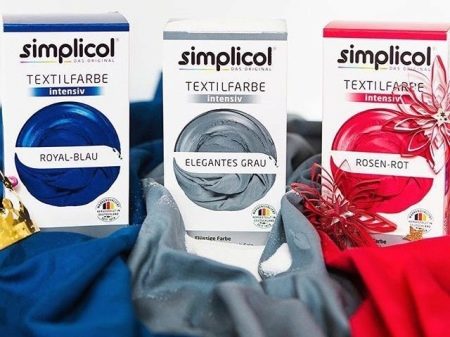
- Decola. These are some of the most popular acrylic paints. The color palette is huge here, so you will definitely find everything you need to recreate the desired pattern. It is necessary to apply paint with a brush along a pre-created contour, some also use stencils. Average drying time of the dye is 2-4 hours.

- Procion H. The manufacturer produces this paint in liquid form. The composition is very easy to work with, suitable even for those who dye fabric for the first time. It can be applied to any material, including denim. The main thing is to properly dilute the concentrate. After dyeing, the fabric must be ironed with an iron and a steamer.

- Dyes "Gamma". Good aniline dye for natural fabrics. The choice of buyers is presented by a rich palette of various colors. After staining, the material will also need to be steamed.

- Elbesoie. This paint is used not only at home, but also on an industrial scale. She is considered one of the best. Fits very well on textile material, uniform, easy to use. Soft tones are obtained by diluting with water.


How to use it correctly?
If you want the thing after dyeing to really acquire a beautiful look, and not become a candidate for discard, then it is very important to take into account a few rules.
The first step is to prepare the thing itself. It must be well washed, rinsed, dried and ironed. If there are stains on the product, you should try to remove them. It is clear that some dirt cannot be removed, sometimes for this the thing is painted. Then the dye should be darker than the stain.
If the things have metal buttons, zippers or fasteners, then it is better to remove them (when drawing a picture, and not completely painting, this rule can be disregarded).


Further technique will depend on the method of application. So, if it is acrylic paint or any other paint applied with a brush, then everything is relatively simple here.You need to choose a suitable pattern, print it, and then apply it to the fabric using a carbon copy. It is best to take a thick needle for this and draw with an eye. So you won't tear the paper... Then the resulting contours are simply outlined with a brush dipped in paint. To make everything work out well, you can practice in advance on plain paper, or print an already color version of the sketch.


Additional tips:
-
it will be much more convenient to paint the drawing if you put something solid or a cardboard base under the fabric;
-
it is better to start coloring with light colors, because if you make a mistake with dark ones, it will be much more difficult to cover the error;
-
after use, the jar of paint must be tightly closed, as it dries quickly in air;
-
brushes after each paint are rinsed in water and blotted with a dry napkin;
-
wait for complete drying for several hours, at which time the item should lie on a table, sofa or any other horizontal surface;
-
finishing stage - ironing from the inside out.

If you decide to paint a thing in water, then the following recommendations will come in handy.
-
The container must be washed... Enamel containers are most suitable, large enough so that the item does not wrinkle in it.
-
It is recommended that the water be either defended or diluted with soda (take a tablespoon for 12 liters of water). For stirring clothes in paint, tools made of wood are used, preferably sticks.
-
The paint is first diluted in a small container, and then poured into the main container. Recommendations for dosage and amount of water are on the packaging, they are different for all manufacturers.
-
The fabric starts to dye after heating... You cannot leave her alone: you will have to stand at the stove all the time and stir the thing in a container in a circle.
-
Pay attention to the color... For example, if you want blue, wait for dark blue. When the outfit is dry, it will brighten and acquire the desired shade.









